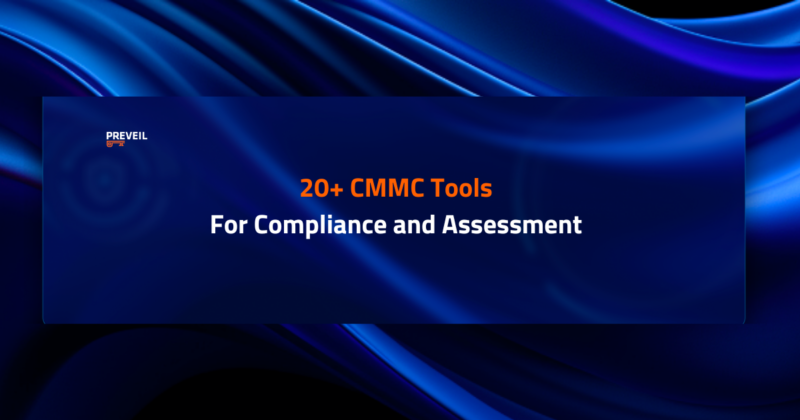Achieving CMMC compliance can feel like a daunting task, but there are tools available to help expedite the process, saving time and money. The tools explored here help address the 110 security controls outlined in NIST SP 800-171, which is the basis for CMMC Level 2.
Below are 5 categories of tools to explore, alongside the NIST 800-171 control families they impact, and a list of solutions to consider:

1. Email and File Sharing to Protect CUI
Primary Practice Areas/ Control Families: Access Control, Audit and Accountability, Identification and Authentication, Maintenance, Physical Protection, System and Communications Protection, System and Information Integrity
Use a secure email and file sharing solution to safeguard Controlled Unclassified Information (CUI).
Possible solutions include PreVeil and Microsoft GCC High; however, PreVeil is the better choice for most defense contractors because it acts as your central hub for CMMC compliance. PreVeil offers several advantages over legacy solutions like Microsoft GCC High:
- Ease of Use: PreVeil integrates seamlessly with your existing email system, avoiding a disruptive overhaul of your IT infrastructure.
- Lower Costs: Defense contractors save 75% vs GCC High because PreVeil deploys seamlessly alongside your existing Office 365 or Exchange, eliminating an expensive rip-and-replace, and only requires licenses for users accessing CUI.
- Free 3rd Party Communication: PreVeil lets you invite any contractor to create a free account, enabling secure communication within minutes.
- Simplified Documentation: PreVeil provides detailed compliance documentation and 1×1 compliance support, saving tens of thousands and hundreds of hours of time.
One defense contractor who received a perfect 110 score on his CMMC JSV Assessment highlighted these benefits: “When it comes to speed to compliance and cost, PreVeil is undoubtedly the right decision. We got it done on time and on budget, saving $200,000 compared to GCC High…if you care about being on time, GCC High is a much bigger risk than PreVeil.”
2. Endpoint Protection Tools
Primary Practice Area/Control Family: Access Control, Configuration Management, Identification and Authentication
Endpoint protection refers to a comprehensive approach to securing devices like laptops, desktops, and mobile phones that access, process, or store CUI. A robust endpoint protection strategy should address the following key areas:
- Device Management: Effective device management allows you to centrally configure and enforce security policies across all your devices. This includes managing user access controls, implementing strong password policies, and ensuring software is kept up-to-date with the latest security patches.
- Possible solutions include Microsoft Intune or Google Endpoint Management
- Anti-virus/Anti-malware: Anti-virus and anti-malware software continuously scans devices for known threats like viruses, malware, and spyware. These solutions can also help prevent the installation of unauthorized software that could compromise your systems.
- Possible solutions include Microsoft Defender, SentinelOne, and Crowdstrike.
- Full Disk Encryption (FDE): Hard drive encryption protects sensitive data at rest by scrambling it using a strong encryption algorithm. This ensures that even if a device is lost or stolen, the data remains unreadable without the decryption key. Note that CMMC requires FIPS 140-2 validated encryption.
- Possible solutions include Bitlocker for Windows and FileVault for Mac.
- Vulnerability Scanning: Vulnerabilities are weaknesses in software or systems that attackers can exploit. Regular vulnerability scanning helps identify these weaknesses so they can be addressed promptly. Tools can automate vulnerability scanning and prioritization, allowing you to focus on the most critical issues first.
- Possible solutions include Microsoft Sentinel, SentinelOne, and Crowdstrike.
- Multi Factor Authentication (MFA): MFA adds an extra layer of security by requiring a second verification factor, such as a code from a smartphone app, in addition to a password. This makes it much more difficult for unauthorized users to gain access to your systems, even if they obtain a stolen password.
- Possible solutions include Microsoft 365 MFA and Duo Federal.
Note that some of these features may already be included in your existing commercial subscriptions. However, it’s crucial to ensure they are properly configured and enabled to meet CMMC compliance standards.
3. SIEM (Optional)
Practice Area/Control Family: Access Control, Audit & Accountability
A Security Information and Event Management (SIEM) aggregates logs and security events from various sources into a central location for analysis. For smaller companies with few employees, manually checking logs may be sufficient. However, even medium-sized organizations can benefit from a SIEM tool.
- Possible solutions to streamline security monitoring and incident response include NeQter, Microsoft Sentinel, and Splunk.
4. GRC and Self-Assessment Tools (Optional)
Practice Area/Control Family: ALL
A Governance, Risk, and Compliance (GRC) tool can help automate compliance tasks and track your progress towards achieving CMMC certification. While not mandatory, a GRC tool can simplify the process and provide valuable insights to improve your overall security posture.
- Possible solutions include ComplyUp, FutureFeed, and Cyturus
5. Security Awareness and Training Tools (Optional)
Practice Area/Control Family: ALL
Building a strong security culture is crucial for CMMC compliance. These tools can help deliver engaging training modules and phishing simulations to educate employees on cybersecurity best practices and how to identify potential threats.
- Solutions include KnowBe4, Proofpoint Security Awareness Training, and PhishLabs.
Summary
By leveraging PreVeil as your CMMC compliance hub and strategically integrating complementary tools, you can streamline the path to meeting the 110 controls of NIST 800-171. This approach protects your CUI, automates tasks, simplifies complex processes, and strengthens your overall security posture.
Have more questions? Schedule a free 15-minute assessment with our compliance team to discuss your specific needs.
*Note these solutions do not constitute an endorsement but rather serve as possible platforms that can be used.